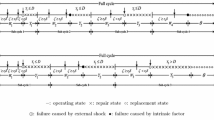Abstract
A generalized mixed shock model, which mixes two run shock models, is developed and analyzed. According to the model, the system subject to both internal degradation and external shocks fails upon the occurrence of \(k_1\) consecutive shocks whose magnitude is between predefined critical values of \(d_1\) and \(d_2\) such that \(d_1<d_2\), or \(k_2\) consecutive shocks whose magnitude is above \(d_2\). The system’s reliability, mean time to failure, and mean residual lifetime are all calculated under the assumption that the lifetime of the system due to internal wear and external shock arrival times follows a phase-type distribution. The best policy for replacement is also discussed. There are also graphical representations and numerical examples for the proposed model, in which both lifetime distribution of internal degradation and the interarrival periods between external shocks follow the Erlang distribution.






Similar content being viewed by others
Code availability
Not applicable.
References
Assaf D, Levikson B (1982) Closure of phase type distributions under operations arising in reliability theory. Ann Probab 10(1):265–269
Auto My Garage, Inc Tire. My garage auto & tire. http://mygarageairdrie.ca/timing-belts/, 2019 (accessed January 7), (2023)
Bozbulut AR, Eryilmaz S (2020) Generalized extreme shock models and their applications. Commun Stat Simul Comput 49(1):110–120
Cha JH, Finkelstein M (2011) On new classes of extreme shock models and some generalizations. J Appl Probab 48(1):258–270
Chin-Diew L, Min X, Barlow RE (2006) Stochastic ageing and dependence for reliability. Springer-Verlag
Cirillo P, Husler J (2011) Extreme shock models: an alternative perspective. Stat Prob Lett 81(1):25–30
Cui LR, Wu B (2019) Extended phase-type models for multistate competing risk systems. Reliabil Eng Syst Saf 181:1–16
Eryilmaz S (2017) Computing optimal replacement time and mean residual life in reliability shock models. Comput Indus Eng 103:40–45
Eryilmaz S, Devrim Y (2019) Reliability and optimal replacement policy for a k-out-of-n system subject to shocks. Reliabil Eng Syst Saf 188:393–397
Eryilmaz S, Tekin M (2019) Reliability evaluation of a system under a mixed shock model. J Comput Appl Math 352:255–261
Gut A, Hüsler J (1999) Extreme shock models. Extremes 2(3):295–307
He QM (2006) Fundamentals of matrix-analytic methods. Springer, New York
Huang XZ, Jin SJ, He XF, He D (2019) Reliability analysis of coherent systems subject to internal failures and external shocks. Reliabil Eng Syst Saf 181:75–83
Li XY, Li YF, Huang HZ, Zio E (2018) Reliability assessment of phased-mission systems under random shocks. Reliabil Eng Syst Safety 180:352–361
Mallor F, Omey E (2001) Shocks, runs and random sums. J Appl Probab 38(2):438–448
Montoro-Cazorla D, Rafael PO, Carmen Segovia M (2007) Survival probabilities for shock and wear models governed by phase-type distributions. Qual Technol Quantitat Manag 4(1):85–94
Montoro-Cazorla D, Perez-Ocon R, Segovia MC (2009) Shock and wear models under policy n using phase-type distributions. Appl Math Model 33(1):543–554
Neuts Marcel F, Meier Kathleen S (1981) On the use of phase type distributions in reliability modelling of systems with two components. Operat Res Spektrum 2(4):227–234
Ozkut M, Eryilmaz S (2019) Reliability analysis under marshall-olkin run shock model. J Comput Appl Math 349:52–59
Perez-Ocon R, Segovia MD (2009) Shock models under a markovian arrival process. Math Comput Model 50(5–6):879–884
Segovia MC, Labeau PE (2013) Reliability of a multi-state system subject to shocks using phase-type distributions. Appl Math Model 37(7):4883–4904
Shanthikumar JG, Sumita U (1983) General shock-models associated with correlated renewal sequences. J Appl Probab 20(3):600–614
Tabriz AA, Khorshidvand B, Ayough A (2016) Modelling age based replacement decisions considering shocks and failure rate. Int J Qual Reliabil Manag 33(1):107–119
Zarezadeh S, Asadi M (2019) Coherent systems subject to multiple shocks with applications to preventative maintenance. Reliabil Eng Syst Saf 185:124–132
Zhao X, Cai K, Wang XY, Song YB (2018) Optimal replacement policies for a shock model with a change point. Comput Indus Eng 118:383–393
Acknowledgements
The author thanks the editor and anonymous referees for their helpful comments and suggestions, which have contributed to the improvement of the paper.
Author information
Authors and Affiliations
Corresponding author
Ethics declarations
Conflict of interest
The author states that there is no conflict of interest.
Additional information
Publisher's Note
Springer Nature remains neutral with regard to jurisdictional claims in published maps and institutional affiliations.
Appendix
Appendix
Proof of (13): Since continuous phase-type random variable R has representation \(PH_c(\varvec{\alpha },\textbf{A})\) and from (1), we have
and
Rights and permissions
Springer Nature or its licensor (e.g. a society or other partner) holds exclusive rights to this article under a publishing agreement with the author(s) or other rightsholder(s); author self-archiving of the accepted manuscript version of this article is solely governed by the terms of such publishing agreement and applicable law.
About this article
Cite this article
Ozkut, M. Reliability and optimal replacement policy for a generalized mixed shock model. TEST 32, 1038–1054 (2023). https://doi.org/10.1007/s11749-023-00864-z
Received:
Accepted:
Published:
Issue Date:
DOI: https://doi.org/10.1007/s11749-023-00864-z
Keywords
- Optimal replacement time
- Reliability
- Mean residual lifetime
- Shock model
- Internal degradation
- Phase-type distributions




